The first question which I am always asked when I say that I am a philatelist is: How much are the rarest stamps worth? This is an intriguing question for many, since rumours abound which state that some of these tiny pieces of paper are worth a tidy fortune. In point of fact, it’s true! Some sales transactions have been known to be in the millions of dollars. Why do these stamps hold so much value? Well, each has its own little history making it unique and famous.
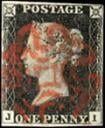 1840 The Penny Black
1840 The Penny BlackThe Penny Black is history’s first pre-paid postage stamp, and was issued by the United Kingdom of Great Britain and Ireland. This stamp, though not exceptionally rare, is worth between $240 and $3000 depending on its condition. However, a specimen of this stamp with a red Maltese cross cancellation sold at auction for more than $2.4 million.
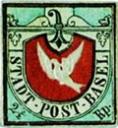 1845 The Basel DoveThis is the first and only stamp issued by the Swiss canton of Basel. It was the first stamp to be printed in three colours (black, blue and crimson). Today, the Basel Dove remains one of the most beautiful classical stamps. Its value is $18 000.
1845 The Basel DoveThis is the first and only stamp issued by the Swiss canton of Basel. It was the first stamp to be printed in three colours (black, blue and crimson). Today, the Basel Dove remains one of the most beautiful classical stamps. Its value is $18 000.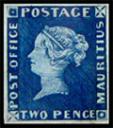 1847 The Blue / Red PennyThese two «Post Office» stamps are the first stamps issued for the postal service in Mauritius Island. The «Post Office» annotation has been liberally commented on. Certain philatelists believe that the printing of this annotation is a mistake, since the usual term used on stamps from the United Kingdom was «Post Paid». This was the term printed on following issues. Approximately 200 specimens were issued with «Post Office», but only 26 have survived down to our day. A cover with two of these stamps sold at auction for $3.8 million.
1847 The Blue / Red PennyThese two «Post Office» stamps are the first stamps issued for the postal service in Mauritius Island. The «Post Office» annotation has been liberally commented on. Certain philatelists believe that the printing of this annotation is a mistake, since the usual term used on stamps from the United Kingdom was «Post Paid». This was the term printed on following issues. Approximately 200 specimens were issued with «Post Office», but only 26 have survived down to our day. A cover with two of these stamps sold at auction for $3.8 million.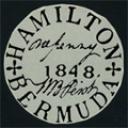 1848 Perot ProvisionalThis is the first stamp issued by Bermudians to inaugurate their capital, Hamilton, and is signed by Bermuda postmaster William Bennet Perot. Today, only 11 copies of this stamp have been discovered. Most of them are in the possession of European royalty, such as the specimen belonging to Queen Elizabeth II. This stamp’s worth is approximately $100,000.
1848 Perot ProvisionalThis is the first stamp issued by Bermudians to inaugurate their capital, Hamilton, and is signed by Bermuda postmaster William Bennet Perot. Today, only 11 copies of this stamp have been discovered. Most of them are in the possession of European royalty, such as the specimen belonging to Queen Elizabeth II. This stamp’s worth is approximately $100,000. 1851 Hawaiian MissionariesThe missionary issue stamps were the first postage stamps used in Hawaii. Their name comes from the fact that they were principally used by the missionaries on their correspondence sent primarily to the United States. Only 16 copies of the 2¢ issue have been found to this day. The «Dawson» cover, showing one 2¢, and one 5¢ missionary stamp, and also two more 3¢ stamps, sold in 1995 for $1.9 million.
1851 Hawaiian MissionariesThe missionary issue stamps were the first postage stamps used in Hawaii. Their name comes from the fact that they were principally used by the missionaries on their correspondence sent primarily to the United States. Only 16 copies of the 2¢ issue have been found to this day. The «Dawson» cover, showing one 2¢, and one 5¢ missionary stamp, and also two more 3¢ stamps, sold in 1995 for $1.9 million.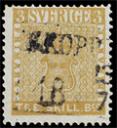 1855 Treskilling YellowOne of the most celebrated and well-known stamp, this Swedish stamp is the result of a printing error. The tre skilling was normally printed in green and the yellow was reserved for the eight skilling issue. The yellow variety of the tre skilling was discovered by a young boy in Sweden by the name of Georg Wilhelm Backman in 1855, while going through his grandmother’s correspondence. No other specimen has ever been discovered to this day, making this stamp completely unique. While practically not bringing any monetary reward to Backman, the stamp was re-sold many times to finally, in 1996, be sold for the last time for the incredible price of $2.27 million. This unbeaten record for the sale of a single stamp makes it the most valuable object created by man, considering its weight and size.
1855 Treskilling YellowOne of the most celebrated and well-known stamp, this Swedish stamp is the result of a printing error. The tre skilling was normally printed in green and the yellow was reserved for the eight skilling issue. The yellow variety of the tre skilling was discovered by a young boy in Sweden by the name of Georg Wilhelm Backman in 1855, while going through his grandmother’s correspondence. No other specimen has ever been discovered to this day, making this stamp completely unique. While practically not bringing any monetary reward to Backman, the stamp was re-sold many times to finally, in 1996, be sold for the last time for the incredible price of $2.27 million. This unbeaten record for the sale of a single stamp makes it the most valuable object created by man, considering its weight and size.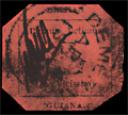 1856 British Guyana 1¢ MagentaFor a long time it has been regarded as the superstar of rare stamps. In 1856, when the inventory of Guyana stamps was almost, totally exhausted, a newspaper company was authorized to print emergency provisional stamps. The simple design features a sailboat in the center of the octagonal stamp with a 4¢ denomination. These provisional stamps were signed by the postmaster in order to avoid counterfeits. In 1875, a young boy of 12 years of age, L. Vernon Vaughan, discovered a specimen of the stamp with «one cent» inscribed instead of «four cents». Over the years, several counterfeits have been discovered, but one, single, authentic copy exists. It rests in a bank vault in Philadelphia, since its owner, the US chemical fortune heir, John E. Du Pont, is presently serving a 30 year sentence for the murder of an Olympic wrestler. Mr. Du Pont shelled out $935 000 in 1980 to acquire this little gem of a stamp.
1856 British Guyana 1¢ MagentaFor a long time it has been regarded as the superstar of rare stamps. In 1856, when the inventory of Guyana stamps was almost, totally exhausted, a newspaper company was authorized to print emergency provisional stamps. The simple design features a sailboat in the center of the octagonal stamp with a 4¢ denomination. These provisional stamps were signed by the postmaster in order to avoid counterfeits. In 1875, a young boy of 12 years of age, L. Vernon Vaughan, discovered a specimen of the stamp with «one cent» inscribed instead of «four cents». Over the years, several counterfeits have been discovered, but one, single, authentic copy exists. It rests in a bank vault in Philadelphia, since its owner, the US chemical fortune heir, John E. Du Pont, is presently serving a 30 year sentence for the murder of an Olympic wrestler. Mr. Du Pont shelled out $935 000 in 1980 to acquire this little gem of a stamp.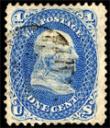 1868 Benjamin Franklin Z-GrillThis American stamp, with a Z-grill, is considered to be the rarest stamp of this country. Only two copies are known to exist, only one of which exchanges hands between private collectors. Thus, only one collector at a time can possess the entire collection of USA stamps. A «grill» is a method of preventing counterfeiting. It consists of embossing a specific pattern of tiny squares into the paper with a high-pressure press. As a result, the cancellation is more readily absorbed into the paper and becomes very difficult to erase. The z-grill was the first grill ever used, and is more visible from the back of the stamp. The first collector to possess a complete USA stamp collection was Robert Zoellner. In 1998, Mr. Zoellner’s complete USA collection was sent to auction, and Donald Sundman, president of the Mystic Stamp Company, acquired the Benjamin Franklin Z-Grill for $935 000. In October 2005, financier Bill Gross exchanged his block of four famous «Inverted Jennies», which he had acquired for almost $3 million, for the celebrated Z-Grill 1868. The spectacular trade made him the new single collector to own a complete collection of 19th Century American stamps.
1868 Benjamin Franklin Z-GrillThis American stamp, with a Z-grill, is considered to be the rarest stamp of this country. Only two copies are known to exist, only one of which exchanges hands between private collectors. Thus, only one collector at a time can possess the entire collection of USA stamps. A «grill» is a method of preventing counterfeiting. It consists of embossing a specific pattern of tiny squares into the paper with a high-pressure press. As a result, the cancellation is more readily absorbed into the paper and becomes very difficult to erase. The z-grill was the first grill ever used, and is more visible from the back of the stamp. The first collector to possess a complete USA stamp collection was Robert Zoellner. In 1998, Mr. Zoellner’s complete USA collection was sent to auction, and Donald Sundman, president of the Mystic Stamp Company, acquired the Benjamin Franklin Z-Grill for $935 000. In October 2005, financier Bill Gross exchanged his block of four famous «Inverted Jennies», which he had acquired for almost $3 million, for the celebrated Z-Grill 1868. The spectacular trade made him the new single collector to own a complete collection of 19th Century American stamps.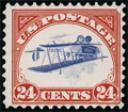 1918 Inverted JennyThe Curtiss JN-4 biplane is the subject of the three first air mail stamps issued by the United States. The 24¢ red and blue with inverted center is probably the most famous American philatelic error and is known under the name of «Inverted Jenny». In the 1910’s, the US Post Office test runs aerial mail transportation. Their efforts result in the inauguration of regular air mail service May 15th, 1918. Stamps are quickly engraved on May 4th, and printed on Friday, May 10th. Quick printing results in at least three misprinted sheets representing the plane upside down, which are found and promptly destroyed.
1918 Inverted JennyThe Curtiss JN-4 biplane is the subject of the three first air mail stamps issued by the United States. The 24¢ red and blue with inverted center is probably the most famous American philatelic error and is known under the name of «Inverted Jenny». In the 1910’s, the US Post Office test runs aerial mail transportation. Their efforts result in the inauguration of regular air mail service May 15th, 1918. Stamps are quickly engraved on May 4th, and printed on Friday, May 10th. Quick printing results in at least three misprinted sheets representing the plane upside down, which are found and promptly destroyed.
However, as in other instances in the past, other sheets of the two-colour stamps with inverted centers make it through despite vigilant efforts to prevent this, and collectors rush to try and track down the stamp. On May 14th, W. T. Robey sees the postmaster take out a complete sheet of 100 stamps with inverted centers, and, with pounding heart, hurries to purchase the sheet. Robey then contacts several stamp collectors and journalists regarding his incredible find, and also hides his sheet from visiting postal inspectors. He quickly sells the sheet to a dealer in Philadelphia, Eugene Klein, for $15 000. Mr. Klein immediately re-sells it to Colonel H. R. Green for $20 000. Based on advice from Klein, Colonel Green separates the sheet in order to sell the stamps for the highest possible price: a block of eight, several blocks of four, and the rest as singles. Colonel Green keeps many of them, and even mounts one in a locket for his wife. On May 18th, 2002, Mrs. Green’s locket is sent to auction, but has no buyer. The philatelic press reports however, that a private sale is subsequently conducted for an undisclosed amount. In October 2005, a block of four «Inverted Jennies» is sold to financier William H. Gross for the sum of $2 970 000. This is the famous block which he then exchanged for one copy of the 1868 Benjamin Franklin Z-Grill.

You've shared Stamps, that's really great. And you have provided information about stamps, it is very important.
BalasHapusThank you so much for this
Alsace Pincode
People will love to read such kind information as they get many benefits regarding this topic. Thank you so much for sharing this.
BalasHapuskullu postal code